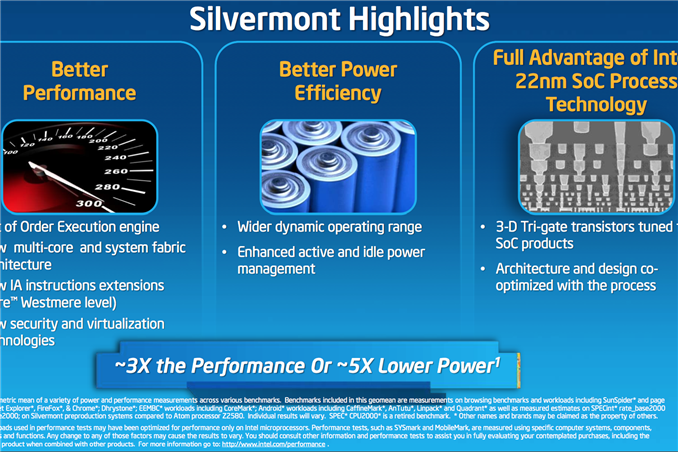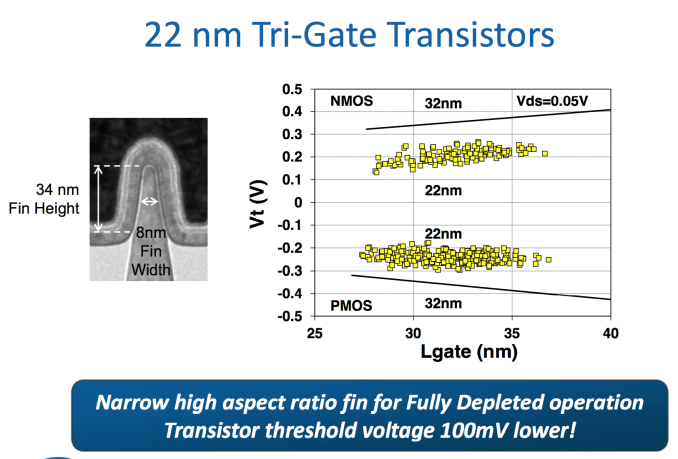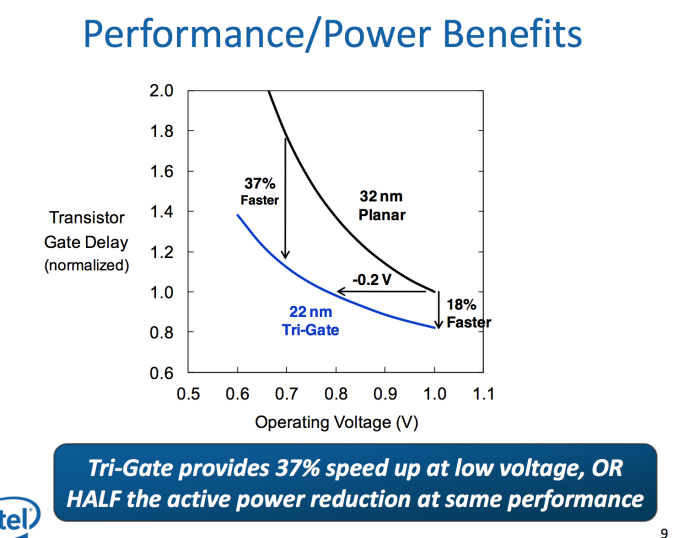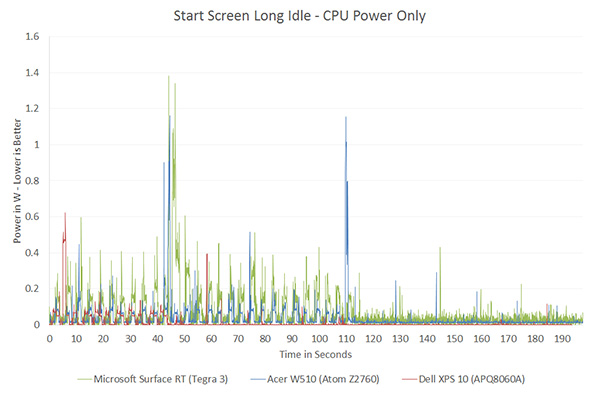Intel’s Silvermont Architecture Revealed: Getting Serious About Mobile
by Anand Lal Shimpi on May 6, 2013 1:00 PM EST- Posted in
- CPUs
- Intel
- Silvermont
- SoCs

The most frustrating part about covering Intel’s journey into mobile over the past five years is just how long it’s taken to get here. The CPU cores used in Medfield, Clover Trail and Clover Trail+ are very similar to what Intel had with the first Atom in 2008. Obviously we’re dealing with higher levels of integration and tweaks for further power consumption, but the architecture and much of the core remains unchanged. Just consider what that means. A single Bonnell core, designed in 2004, released in 2008, is already faster than ARM’s Cortex A9. Intel had this architecture for five years now and from the market’s perspective, did absolutely nothing with it. You could argue that the part wasn’t really ready until Intel had its 32nm process, so perhaps we’ve only wasted 3 years (Intel debuted its 32nm process in 2010). It’s beyond frustrating to think about just how competitive Intel would have been had it aggressively pursued this market.
Today Intel is in a different position. After acquisitions, new hires and some significant internal organizational changes, Intel seems to finally have the foundation to iterate and innovate in mobile. Although Bonnell (the first Atom core) was the beginning of Intel’s journey into mobile, it’s Silvermont - Intel’s first new Atom microarchitecture since 2008 - that finally puts Intel on the right course.
Although Silvermont can find its way into everything from cars to servers, the architecture is primarily optimized for use in smartphones and then in tablets, in that order. This is a significant departure from the previous Bonnell core that was first designed to serve the now defunct Mobile Internet Devices category that Intel put so much faith in back in the early to mid 2000s. As Intel’s first Atom architecture designed for mobile, expectations are high for Silvermont. While we’ll have to wait until the end of the year to see Silvermont in tablets (and early next year for phones), the good news for Intel is that Silvermont seems competitive right out of the gate. The even better news is that Silvermont will only be with us for a year before it gets its first update: Airmont.
 Intel made this announcement last year, but Silvermont is the beginning of Intel’s tick-tock cadence for Atom. Intel plans on revving Atom yearly for at least the next three years. Silvermont introduces a new architecture, while Airmont will take that architecture and bring it down to 14nm in 2014/2015. One year later, we’ll see another brand new architecture take the stage also on 14nm. This is a shift that Intel needed to implement years ago, but it’s still not too late.
Intel made this announcement last year, but Silvermont is the beginning of Intel’s tick-tock cadence for Atom. Intel plans on revving Atom yearly for at least the next three years. Silvermont introduces a new architecture, while Airmont will take that architecture and bring it down to 14nm in 2014/2015. One year later, we’ll see another brand new architecture take the stage also on 14nm. This is a shift that Intel needed to implement years ago, but it’s still not too late.
Before we get into an architectural analysis of Silvermont, it’s important to get some codenames in order. Bonnell was the name of the original 45nm Atom core, it was later shrunk to 32nm and called Saltwell when it arrived in smartphones and tablets last year. Silvermont is the name of the CPU core alone, but when it shows up in tablets later this year it will do so as a part of the Baytrail SoC and a part of the Merrifield SoC next year in smartphones.
22nm
To really understand the Silvermont story, you need to first understand Intel’s 22nm SoC process. Two years ago Intel announced its 22nm tri-gate 3D transistors, which would eventually ship a year later in Intel’s Ivy Bridge processors. That process wasn’t suited for ultra mobile. It was optimized for the sort of high performance silicon that was deployed on it, but not the ultra compact, very affordable, low power silicon necessary in smartphones and tablets. A derivative of that process would be needed for mobile. Intel now makes two versions of all of its processes, one optimized for its high performance CPUs and one for low power SoCs. P1270 was the 22nm CPU process, and P1271 is the low power SoC version. Silvermont uses P1271. The high level characteristics are the same however. Intel’s 22nm process moves to tri-gate non-planar transistors that can significantly increase transistor performance and/or decrease power.
This part is huge. The move to 22nm 3D transistors lets Intel drop threshold voltage by approximately 100mV at the same leakage level. Remember that power scales with the square of voltage, so a 100mV savings depending on what voltage you’re talking about can be very huge. Intel’s numbers put the power savings at anywhere from 25 - 35% at threshold voltage. The gains don’t stop there either. At 1V, Intel’s 22nm process gives it an 18% improvement in transistor performance or at the same performance Intel can run the transistors at 0.8V - a 20% power savings. The benefits are even more pronounced at lower voltages: 37% faster performance at 0.7V or less than half the active power at the same performance.
The end result here is Intel can scale frequency and/or add more active logic without drawing any more power than it did at 32nm. This helps at the top end with performance, but the vast majority of the time mobile devices are operating at very lower performance and power levels. Where performance doesn’t matter as much, Intel’s 22nm process gives it an insane advantage.
If we look back at our first x86 vs. ARM performance data we get a good indication of where Intel’s 32nm process had issues and where we should see tangible improvements with the move to 22nm:
Qualcomm’s 28nm Krait 200 was actually able to get down to lower power levels than Intel could at 32nm. Without having specific data I can’t say for certain, but it’s extremely likely that with Silvermont Intel will be able to drive down to far lower power levels than anything we’ve ever measured.
Understanding what Intel’s 22nm process gives it is really key to understanding Silvermont.













174 Comments
View All Comments
althaz - Monday, May 6, 2013 - link
I don't think you fully grasp the situation. Whilst Intel definitely can (and realistically should) take a strong leadership position in the mobile sector, companies like Qualcomm aren't going anywhere - Intel still won't (be able to?) compete on price, which means even if they take the lions-share of the market, there will be enough left for others to survive (they'll be a lot better off than AMD who sells more-expensive-to-manufacture chips for cheaper that perform worse and use more power).Although I wouldn't be too confident about nVidia, as they are yet to show they can compete with the likes of Qualcomm, let alone Intel.
R0H1T - Tuesday, May 7, 2013 - link
They most certainly will not "take the lions-share of the market" because that belongs to the ultra thin margin chipmakers like Mediatek/Allwinner that deliver quad core ARM v7 based SoC in that 10~20$ range where Intel will not & cannot compete because of their relatively high(er) cost structure !Khato - Tuesday, May 7, 2013 - link
This is an argument that never makes sense to me. Yes, Intel won't go into a market unless the margins make it worthwhile... but do you not realize how cheap it is for Intel to make value processors on a deprecated node? Remember, Allwinner and Mediatek may operate on ultra thin margins, but that's in large part because the majority of the margins on their product go to the foundry they use. aka, when all the high end products are using Airmont cores Intel can keep making use of their 22nm capacity for awhile churning out 'old' Silvermont based products for the value market and simply get closer to the 'operating point' margin for that node.R0H1T - Wednesday, May 8, 2013 - link
I can't say how much TSMC charges for those chips but from what I know the single biggest cost of operations for Intel, outside of their R&D spending & foundry equipment upgrades, must be manpower & the difference between a Chinese/Taiwanese firm vs Intel in this particular dept would be a major one ! This is the real cost advantage that most smaller firms enjoy vis-a-vis Intel & for the foreseeable future they'll continue with this advantage.xTRICKYxx - Tuesday, May 7, 2013 - link
I didn't feel like this article is Intel PR crap. I read it all and I looked at all the improvements that are inbound; and I couldn't help but feel excited about Silvermont just like Anand.I cannot wait to see some benchmarks in the next few months.
Silma - Tuesday, May 7, 2013 - link
On lack of AMD's comparison: there is nothing to compare and while one should tread cautiously with Intel's slides one should not tread at all with AMD's slides because AMD has a huge legacy of promises not held - how many time did we hear it would catch up in notebook or desktops, in performance or performance/watt. While Intel disappoints from time to time (Pentium 4) AMD disappoints most of the time, its last interesting product was the Opteron. Like most companies without vision it ends up doing stupid mergers instead of concentrating on core business.On Intel vs ARM. Silvermont looks promising but Intel needs to accelerate its roadmap. At the end of the year it probably won't compete against a 28nm A15. Qualcomm will not sleep for a year. Also it will have to invest heavily into marketing and OEM incentives if it seriously wants a share of the mobile pile. Will shareholders
ET - Tuesday, May 7, 2013 - link
I'm excited. A 7-8" full Windows tablet with decent performance would be very neat. I'll wait to see what performance this gets in games. I don't need much, just enough to run adventure games and such.R0H1T - Tuesday, May 7, 2013 - link
Then get ready to shell out upwards of 500$ /:pensive69 - Tuesday, May 7, 2013 - link
can't stand getting a partially functioning market focused 'hack' on a cellphone.if the 22nm drill provides a full computer in a smaller form then factor me in!
i don't care which firm does it...like those kids in the commercial
we just want more we want more :).
love it.
Laststop311 - Tuesday, May 7, 2013 - link
this chip will have to pull off a miracle to drive full windows 8 and the everyday apps people use. Seems like it's going to average maybe slightly over 2x performance. That seems like a lot but when you see how poor current atoms are double that performance still is not enough. Does have potential in android phones/tablets and windows 8 phones/tablets as long as it's windows rt on the tablet. Atom still is not good enough for full windows 8